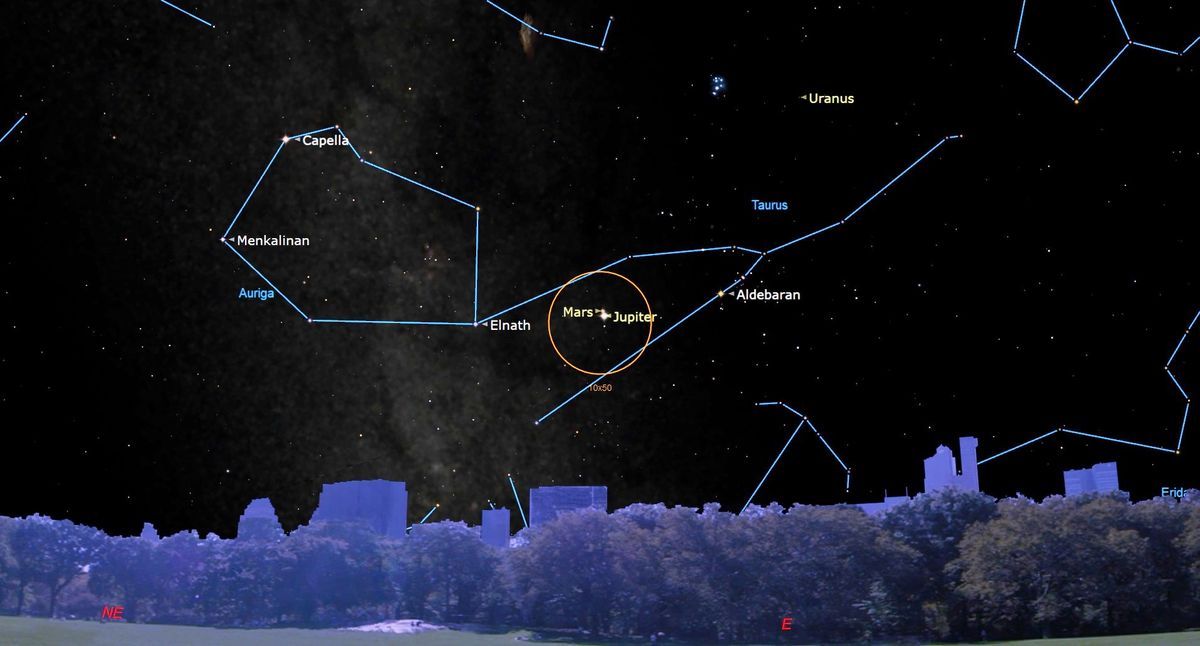Be sure to set your alarm clock for at least a couple of hours before sunrise on Wednesday morning (Aug. 14), for if you have a clear view toward the east, you’ll be able to see brilliant Jupiter forming a most unusual and spectacular “double planet” with Mars.
These two worlds will glow respectively at magnitudes -2.2 and +0.8, which in terms of a brightness ratio means that Jupiter will outshine Mars by a factor of nearly 16 to 1. Yet in spite of their great difference in brightness, they should make for an eye-catching sight visually.
Mars will appear to hover just above and slightly to the left of Jupiter.
Placement against a familiar winter pattern
Silvery Jupiter and pumpkin-colored Mars are currently located within a zodiacal star pattern that is typically high in our sky on frosty winter evenings; both are located in the middle of Taurus the Bull, midway between the horns and roughly 8 degrees to the left of the Bull’s “angry eye,” the bright orange-hued star Aldebaran which at this moment in time pretty much matches up to Mars both in terms of brightness and color.
Both planets will come up over the east-northeast horizon just before 1 a.m. local daylight time, and two hours later they will be well-placed for viewing.
The red planet has spent much of 2024 dawdling in the morning sky, never getting very high above the eastern horizon by the break of dawn. But finally, it has progressed far enough away from the sun to be more easily seen at a higher altitude in the predawn sky. And it is also becoming a bit brighter as we get progressively closer to it. At the start of August, it was 148.7 million miles (239.3 million km) away. By month’s end, that distance will be reduced by 15.8 million miles (25.4 million km).
How close?
As to how close the planets will appear relative to each other, from the Eastern U.S., the closest approach will come during late morning. At 10:55 a.m. EDT, they will be separated by just 18 arc minutes or 0.3 degrees. That amounts to just three-fifths of the apparent diameter of the moon. But several hours earlier, at the start of morning twilight, the planets will still be quite close together, separated by just 20 arc minutes. The planets will appear similarly close for viewers across the rest of the contiguous U.S.
A separation of only 20 arc minutes means that you’ll be able to fit both planets in the view of a telescope employing low-to-moderate magnification.
But telescopically, Mars appears quite small even in a moderately large telescope, its disk size measures only about 6 arc seconds across. In contrast, Jupiter appears about six times larger and in addition to the cloud bands that cross its disk, there is also the view of the famous Galilean satellites. Of the four, three will be visible this this morning on one side of Jupiter. Moving outbound from the big planet you’ll see Io, followed closely by Europa and much farther away will be Ganymede. On the other side of Jupiter, sitting all by itself will be Callisto.
How rare?
In the mornings following Aug. 14, Mars will quickly move away from Jupiter at a rate of about one-half degree per day to the east. By month’s end, they will be separated by roughly 8½ degrees.
Since the year 2000, Jupiter and Mars have been in conjunction 11 other times, with Mars overtaking the slower Jupiter on an average of once about every 26 to 27 months. The last time they were together was on May 29, 2022. After Wednesday morning, they will cross paths with each other again on Nov. 15, 2026.
While this year’s Mars-Jupiter conjunction will be unusually close, an even closer encounter will occur on the evening of Dec. 1, 2033. On that night, the two planets will be separated by a mere 0.2 degrees; just 12 arc minutes!
Mark your calendars.
Joe Rao serves as an instructor and guest lecturer at New York’s Hayden Planetarium. He writes about astronomy for Natural History magazine, the Farmers’ Almanac and other publications.





















Discussion about this post